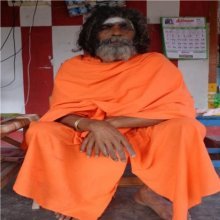Mona, Moṇa: 14 definitions
Introduction:
Mona means something in Hinduism, Sanskrit, Buddhism, Pali, Marathi, Jainism, Prakrit, Hindi. If you want to know the exact meaning, history, etymology or English translation of this term then check out the descriptions on this page. Add your comment or reference to a book if you want to contribute to this summary article.
Images (photo gallery)
Languages of India and abroad
Pali-English dictionary
Source: BuddhaSasana: Concise Pali-English Dictionarymona : (nt.) wisdom; self-possession; silence.
Source: Sutta: The Pali Text Society's Pali-English DictionaryMona, (nt.) (fr. muni, equal to *maunya taken by Nd as root of moneyya) wisdom, character, self-possession Sn. 540 (°patha=ñāṇa-patha SnA 435), 718, 723; Nd1 57; Nd2 514 A (=ñāṇa & paññā); Th. 1, 168 (what is monissaṃ? fut. 1st sg. of ?). (Page 542)

Pali is the language of the Tipiṭaka, which is the sacred canon of Theravāda Buddhism and contains much of the Buddha’s speech. Closeley related to Sanskrit, both languages are used interchangeably between religions.
Marathi-English dictionary
Source: DDSA: The Molesworth Marathi and English Dictionarymōnā (मोना).—a (mauna S) Dumb. 2 Mute. 3 For figurative applications see mukā.
Source: DDSA: The Aryabhusan school dictionary, Marathi-Englishmōnā (मोना).—m A plantain-stole or sucker.
--- OR ---
mōnā (मोना).—a Dumb; mute.
Marathi is an Indo-European language having over 70 million native speakers people in (predominantly) Maharashtra India. Marathi, like many other Indo-Aryan languages, evolved from early forms of Prakrit, which itself is a subset of Sanskrit, one of the most ancient languages of the world.
Sanskrit dictionary
Source: DDSA: The practical Sanskrit-English dictionaryMoṇa (मोण).—
1) A dried fruit.
2) A basket for keeping snakes.
3) A kind of fly.
Derivable forms: moṇaḥ (मोणः).
Source: Cologne Digital Sanskrit Dictionaries: Shabda-Sagara Sanskrit-English DictionaryMoṇa (मोण).—m.
(-ṇaḥ) 1. Dried fruit. 2. A sort of water-fly, the crocodile-fly. 3. A basket for carrying snakes in. E. muṇ to vow, aff. ghañ .
Source: Cologne Digital Sanskrit Dictionaries: Benfey Sanskrit-English DictionaryMoṇa (मोण).—m. 1. Dried fruit. 2. A crocodile. 3. A fly. 4. A basket for carrying snakes in.
Source: Cologne Digital Sanskrit Dictionaries: Monier-Williams Sanskrit-English Dictionary1) Moṇa (मोण):—m. dried fruit, [cf. Lexicographers, esp. such as amarasiṃha, halāyudha, hemacandra, etc.]
2) a kind of fly, [cf. Lexicographers, esp. such as amarasiṃha, halāyudha, hemacandra, etc.]
3) a basket in which snakes are carried, [cf. Lexicographers, esp. such as amarasiṃha, halāyudha, hemacandra, etc.]
Source: Cologne Digital Sanskrit Dictionaries: Yates Sanskrit-English DictionaryMoṇa (मोण):—(ṇaḥ) 1. m. Dried fruit; a water fly; a snake basket.
[Sanskrit to German]
Sanskrit, also spelled संस्कृतम् (saṃskṛtam), is an ancient language of India commonly seen as the grandmother of the Indo-European language family (even English!). Closely allied with Prakrit and Pali, Sanskrit is more exhaustive in both grammar and terms and has the most extensive collection of literature in the world, greatly surpassing its sister-languages Greek and Latin.
Hindi dictionary
Source: DDSA: A practical Hindi-English dictionaryMonā (मोना):—(a) clean-shaven (person).
...
Prakrit-English dictionary
Source: DDSA: Paia-sadda-mahannavo; a comprehensive Prakrit Hindi dictionaryMoṇa (मोण) in the Prakrit language is related to the Sanskrit word: Mauna.
Prakrit is an ancient language closely associated with both Pali and Sanskrit. Jain literature is often composed in this language or sub-dialects, such as the Agamas and their commentaries which are written in Ardhamagadhi and Maharashtri Prakrit. The earliest extant texts can be dated to as early as the 4th century BCE although core portions might be older.
Kannada-English dictionary
Source: Alar: Kannada-English corpusMoṇa (ಮೊಣ):—
1) [noun] the length of the arm from the end of the middle finger to the elbow, used as a unit of linear measure.
2) [noun] the joint uniting the forearm with the upper arm; the elbow.
3) [noun] the joint of the thigh or femur with the lower leg; the knee.
--- OR ---
Mōṇa (ಮೋಣ):—[noun] a dried fruit.
--- OR ---
Mōna (ಮೋನ):—
1) [noun] a refraining from speech; silence.
2) [noun] a vow of refraining from speech.
3) [noun] a becoming speechless caused by the separation from one’s lover.
Kannada is a Dravidian language (as opposed to the Indo-European language family) mainly spoken in the southwestern region of India.
See also (Relevant definitions)
Starts with (+32): Monaanhno, Monaatlou, Monabete, Monacu, Monacugollu, Monadale, Monadenium heteropodum, Monadenium lugardae, Monagamtu, Monagol, Monagollu, Monagu, Monaguruva, Monai, Monaittotai, Monajata, Monaka, Monakaalu muruka, Monakai, Monakal.
Ends with: Amona, Argemona, Behmona, Camona, Kadumona, Kalamona, Kolomona, Kuawa momona, Mamona, Momona, Munmona, Namona, Ocoyanmona, Ocueyan-mona, Philemona, Samona, Small leaf carmona, Tuber stemona.
Full-text: Ocueyan-mona, Monajata, Nakramakshika, Mauna, Monaka, Iraivarai, Monai, Munana, Cinmuttirai, Purnamasa, Monava, Prasadivarika, Nalamina, Chettavarai, Unanku, Abhayagirivihara, Moli, Muni.
Relevant text
Search found 6 books and stories containing Mona, Mōnā, Monā, Moṇa, Mōṇa, Mōna; (plurals include: Monas, Mōnās, Monās, Moṇas, Mōṇas, Mōnas). You can also click to the full overview containing English textual excerpts. Below are direct links for the most relevant articles:
Look Within < [April – June, 2008]
What is Creative Art? < [July – September, 1988]
Scientist Painters < [January – March, 2003]
Vinaya Pitaka (1): Bhikkhu-vibhanga (the analysis of Monks’ rules) (by I. B. Horner)
Apadana commentary (Atthakatha) (by U Lu Pe Win)
Commentary on Biography of the thera Caṅkamanadāyaka < [Chapter 5 - Upālivagga (section on Upāli)]
Establishing Many Monasteries < [Part 3 - Discourse on proximate preface (santike-nidāna)]
Commentary on the biography of the the thera Sāriputta < [Chapter 1 - Buddhavagga (Buddha section)]
Taliesin (by David William Nash)
Chapter VII - The Welsh Romances
Chapter IV - The Mythological Poems
Now Is The Knowing (by Ajahn Sumedho)
The Great Chronicle of Buddhas (by Ven. Mingun Sayadaw)
Chapter 3 - Seeing the Four Great Omens < [Volume 2.1]
